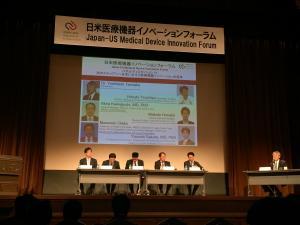A few weeks ago, as I’ve written about in recent posts, I attended two conferences in Japan related to health care innovation and management.
In Japan, there is much focus right now on Prime Minister Abe’s “womenomics” as part of his “Abenomics” initiatives.
The only other conference event I’ve been to this year in Japan was the ACCJ’s Women in Business Summit, where you might expect a large percentage of the audience to be women.
However, my recent experiences in the past week were more in line with observations about the lack of female participation in the workforce that are reported frequently in the Japan.
Where were the women?
I enjoyed the Japan-U.S. Medical Device Innovation Summit the other week and have written about some of the my top takeaways in a previous post.
I would have expected start-up culture (attracting younger generations) to have a greater representation of females engaged in leadership roles that typical in Japan, so I was surprised when I looked around the room and realized that I was a rare attendee.
A sea of suits in the audience
Early into the program, I took an intentional look around the room and realized that there were hardly any women in the audience!
I did a rough count and estimated that in an audience of probably about 300+ people, I was one of about ten women total in attendance (excluding the all female interpreter team and the event coordinators helping us at registration).
I was so surprised that I tweeted during the first break about my observation! (I’m not a big mid-conference tweeter).
In a #japan / U.S. conference on medical industry innovation of 250-300 attendees I am one of about 10 women.
— Katie Anderson (@kbjanderson) November 2, 2015
And I believe I was the only foreign woman in attendance. I wore a brightly colored sweater (not the standard neutral or dark top) with black pants and jacket – I was the only “pop” of color in a room of dark suits, as the Japanese women blended into the dark suits.
My male colleagues with whom I attended the conference did not notice this disparity until I pointed it out. It is the norm in the country.
A younger female Japanese colleague (one of the few women attendees) noticed it (she just spent a year in the U.S.), but she too said that’s just how it is right now in Japan. She’s used to it….
Homogenous speaker line-up

In addtion to the lack of women audience members, the conference speakers were 100% men.
And there were no female speakers – either Japanese or foreigners.
This says a lot to me about the state of innovation and entrepreneurship — in both the U.S. and Japan.
I appreciated hearing the perspectives of all the male experts from both the U.S. and Japan – they each shared valuable insights and were experts in their fields.
However, it was a missed opportunity, from my perspective, that there were no female speakers from either country.
Start-up culture in Japan
Mark Graban made me aware of a recent Wall Street Journal article titled Japan Inc. Hires More Women, but Men Still Hold Top Jobs that confirmed many of these observations related to innovation culture and gender issues.
The article calls Japan’s startup culture “sluggish” and cites that:
“men account for about siz in seven new business startups, a number that hasn’t changed recently, accordingly to the government-affiliated Japan Finance Corp.”
Change comes from the top
If Japan – or any country for that matter – wants to engage more women in leadership and innovation as foster a robust“ecosystem” (one of the key buzzwords used throughout the day) of entrepreneurship, its leaders need to take a proactive role in seeking out female leaders and speakers.
Model the way to promote diversity and engagement
Many conference speakers spoke about the concept of mentorship and supporting the next generation of up and coming entrepreneurs. They can help this by including women role models in their speaker line-up. In support of their goal of building an ecosystem of innovation in Japan, conference organizers should consider for their future events how they can include some women speakers as well – either Japanese or foreigners.
In my Twitter feed last week, I was encouraged by some tweets by Eric Ries of the “Lean Start-up” highlighting the diversity that he has actively sought out in the most recent “Lean Start-up” conference held in the San Francisco Bay Area this week.
11/ I hope our experience can serve as a model for other conferences to follow. It's not a mystery. There is a real process you can follow.
— Eric Ries (@ericries) November 14, 2015
I was pleased to see that at least one of the new fellows in the Stanford Biodesign program in Japan is female. She got up and asked a question during the event and brought a female voice to the table.
I look forward to seeing how the organizers of the Summit engage more women in their event – both as speakers and attendees – next year. Perhaps this female fellow can contribute as a case study of lessons learned (with her male colleagues too).
More Women at Healthcare Conference
In contrast to the Innovation Summit, the Conference for Health Care in Fukuoka has a greater participation rate by women. My rough estimate by looking around the conference room was that 1/3 of the audience were female.
While men still dominated the speaker line-up, two women were speakers- one Japanese presenter and one of the two invited guests from Virginia Mason was co-faciliated the event and gave multiple presentations.
You can read about my reflections and learnings from the Conference on Health Care in other posts. It was interesting to hear about how Japanese hospitals are approaching quality and process improvement, though you might be surprised to learn that lean is in its early days of being applied in healthcare settings.











